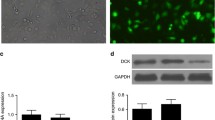Abstract
Objective
In this study, RNA interference was used to evaluate the effects of HMGB1 expression on cell cycle and proliferation of the human cervical cancer cell line HeLa.
Methods
We had previously constructed and screened effective eukaryotic expression vectors carrying PGCsi3.0-1/HMGB1 siRNA and PGCsi3.0-3/HMGB1 siRNA, then the vectors were transfected into HeLa cells. The expression of HMGB1 before and after transfection in HeLa cells were detected by RT-PCR and Western blot. The cell viability and proliferating activity was tested by Trypan blue dye test and MTT, and the cell cycle was determined by flow cytometry.
Results
The introduction of PGCsi3.0-1/HMGB1 siRNA and PGCsi3.0-3/HMGB1 siRNA inhibited the expression of HMGB1 mRNA and protein efficiently and specifically, there was a significant difference between the siRNA groups and the control groups (P < 0.05). The proliferation speed of PGCsi3.0-1 group and PGC si3.0-3 group were obviously slower than those of PGCsi3.0-Neg group and non-transfected group. Flow cytometry showed that the content of DNA in G2 phase in PGCsi3.0-1 group and PGCsi3.0-3 group were obviously more than those in PGCsi3.0-Neg group and non-transfected group, but the content in S phase was less (P < 0.01). The progression of cell cycle was arrested from G2 to S phase.
Conclusion
PGCsi3.0-1/HMGB1 siRNA and PGCsi3.0-3/HMGB1 siRNA could specially suppress the expression of HMGB1 gene, inhibit the proliferation speed of HeLa cells effectively, and arrest the progression of cell cycle from G2 to S phase. RNAi provides a new approach to the bio-therapy of cervical cancer.
Similar content being viewed by others
References
Tang D, Kang R, Zeh HJ 3rd, et al. High-mobility group box 1 and cancer. Biochim Biophys Acta 2010; 1799:131–140.
Meng YX, Chen J, Lu ZH, et al. Effect of S-100A4 on tumorigenesis, progression, and metastasis. Basic & Clinical Medicine 2006; 26: 1383–1388 (Chinese).
Littlepage LE, Sternlicht MD, Rougier N, et al. Matrix metalloproteinases contribute distinct roles in neuroendocrine prostate carcinogenesis, metastasis, and angiogenesis progression. Cancer Res 2010; 70: 2224–2234.
Ozols RF, Herbst RS, Colson YL, et al. Clinical cancer advances 2006: major research advances in cancer treatment, prevention, and screening—a report from the American Society of Clinical Oncology. J Clin Oncol 2007; 25: 146–162.
Guo SK, Qiao YH, Zhao XL. Changes of serum protein in patients with cervical cancer after radical hysterectomy and pelvic lymphadenectomy. Zhongliu Fangzhi Yanjiu Zazhi 2006; 13: 1730–1733 (Chinese).
Ogilvie GS, van Niekerk DJ, Krajden M, et al. A randomized controlled trial of Human Papillomavirus (HPV) testing for cervical cancer screening: trial design and preliminary results. BMC Cancer 2010; 10: 111.
Bousarghin L, Touze A, Gaud G, et al. Inhibition of cervical cancer cell growth by human papillomavirus virus-like particles packaged with human papillomavirus oncoprotein short hairpin RNAs. Mol Cancer Ther 2009; 8: 357–365.
Huang QX, Wang GB, Sun NF, et al. Inhibitory effects of high mobility group box 1 antisense nucleotide on invasion of human pancreatic cancer cell line PCNA-1. Ai Zheng 2004; 23: 1036–1040 (Chinese).
Moriwaka Y, Luo Y, Ohmori H, et al. HMGB1 attenuates anti-metastatic defense of the lymph nodes in colorectal cancer. Pathobiology 2010; 77: 17–23.
Ulloa L, Messmer D. High-mobility group box 1 (HMGB1) protein: friend and foe. Cytokine Growth Factor Rev 2006; 17: 189–201.
Müller S, Ronfani L, Bianchi ME, et al. Regulated expression and subcellular localization of HMGB1, a chromatin protein with a cytokine function. J Intern Med 2004; 255: 332–343.
Ichim TE, Li M, Qian H, et al. RNA interference: a potent tool for gene-specific therapeutics. Am J Transplant 2004; 4: 1227–1236.
Song DX, Chen AM, Guo JF, et al. The effect of specific inhibition of HMGB1 gene expression by siRNA on the proliferation of human prostate carcinoma cell line PC-3. Zhongguo Zhongliu Linchuang 2008; 35: 339–343 (Chinese).
Huang QX, Sun NF, Wang GB, et al. Expression of HMGB1 protein in human pancreatic carcinoma. Shiyong Zhongliu Zazhi 2004; 19:19–23 (Chinese).
Zhu MG, Zhang X, Yuan HY, et al. Effects of HMGB1 silence by RNA interference on the apoptosis and cell cycle of hepatocarcinoma cells. Zhongguo Mianyixue Zazhi 2007; 7: 634–636 (Chinese).
Zhang P, Liu Y, Wu ZH, et al. Effects of high mobility group box-1 silencing upon the invasion and proliferation in human lung cancer cell L9981 by RNA inhibition. Zhonghua Yixue Zazhi 2009; 89: 3156–3159 (Chinese).
Gnanasekar M, Thirugnanam S, Ramaswamy K. Short hairpin RNA (shRNA) constructs targeting high mobility group box-1 (HMGB1) expression leads to inhibition of prostate cancer cell survival and apoptosis. Int J Oncol 2009; 34: 425–431.
Van Beijnum JR, Buurman WA, Griffioen AW. Convergence and amplification of toll-like receptor (TLR) and receptor for advanced glycation end products (RAGE) signaling pathways via high mobility group B1 (HMGB1). Angiogenesis 2008; 11: 91–99.
Riuzzi F, Sorci G, Donato R. RAGE expression in rhabdomyosarcoma cells RESULTS in myogenic differentiation and reduced proliferation, migration, invasiveness, and tumor growth. Am J Pathol 2007; 171: 947–961.
Taguchi A, Blood DC, del Toro G, et al. Blockade of RAGE-amphoterin signaling suppresses tumor growth and metastases. Nature 2000; 405: 354–360.
Bahnassy AA, Zekri AR, El-Houssini, et al. Cyclin A and cyclin D1 as significant prognostic markers in colorectal cancer patients. BMC Gastroenterol 2004; 4: 22.
Stacey D W. CyclinD1 serves as cell cycle regulatory switch in actively proliferating cells. Curr Opin Cell Biol 2003; 15: 158–163.
Reisinger H, Steinfellner W, Katinger H, et al. Serumfree transfection of CHO cells with chemically defined transfection systems and investigation of their potential for transient and stable transfection. Cytotechnology 2009; 60: 115–123.
Hofacker IL, Tafer H. Designing optimal siRNA based on target site accessibility. METHODS Mol Biol 2010; 623: 137–154.
Author information
Authors and Affiliations
Corresponding author
About this article
Cite this article
Qiu, Yy., Wang, Hy. & Hao, Q. Effects of HMGB1 expression suppressed by siRNA on cell cycle and proliferation of human cervical cancer cell line HeLa. Clin. Oncol. Cancer Res. 7, 128–133 (2010). https://doi.org/10.1007/s11805-010-0507-y
Received:
Accepted:
Published:
Issue Date:
DOI: https://doi.org/10.1007/s11805-010-0507-y




